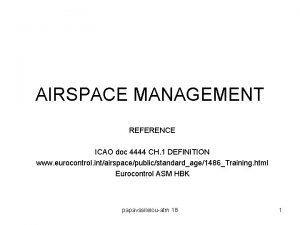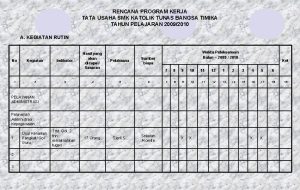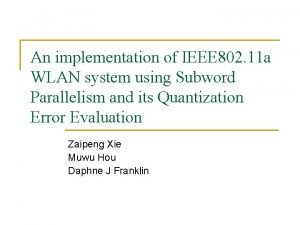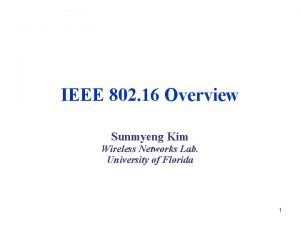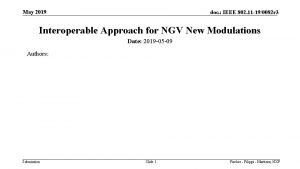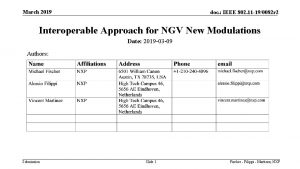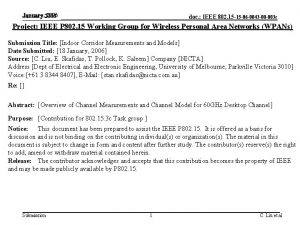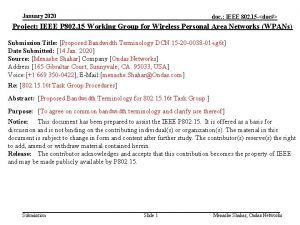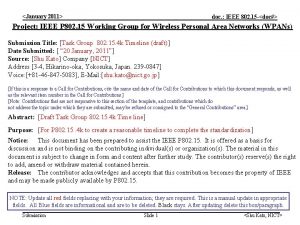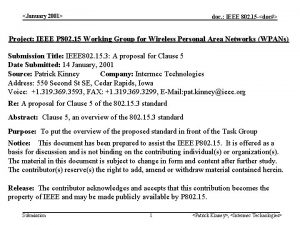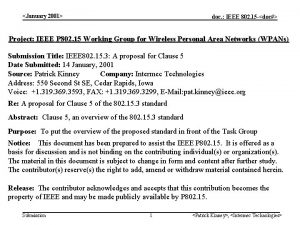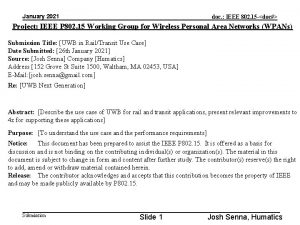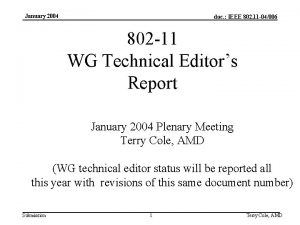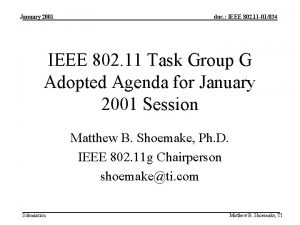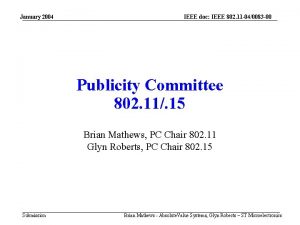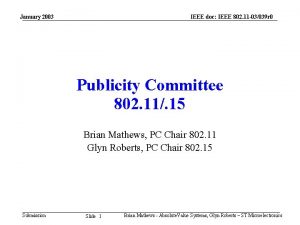January 2019 doc IEEE 802 11 190082 r















- Slides: 15

January 2019 doc. : IEEE 802. 11 -19/0082 r 1 Interoperable Approach for NGV New Modulations Date: 2019 -01 -09 Authors: Submission Slide 1 Fischer - Filippi - Martinez, NXP

January 2019 doc. : IEEE 802. 11 -19/0082 r 1 Abstract • This submission provides technical details on a new PPDU and waveform design for NGV, bringing performance improvements, while maintaining full backward compatibility with legacy IEEE 802. 11 p stations and providing It fairness for access to the channel among all stations. • The new PPDU can include two different sections, which use two different modulations. This facilitates a smooth transition from an environment dominated by legacy 802. 11 p equipment to one with increasing amounts of 802. 11 bd equipment. Submission Slide 2 Fischer - Filippi - Martinez, NXP

January 2019 doc. : IEEE 802. 11 -19/0082 r 1 Introduction • In this document we provide technical details on a new PPDU and waveform design for NGV, bringing performance improvements, while maintaining full backward compatibility with legacy IEEE 802. 11 p stations, by means of physical layer parameter adaptation (such as MCS adaptation). • This new PPDU design is fully compatible with the adaptive retransmission technique that was presented to the NGV SG (see 11 -18/1186 and 11 -18/1577). The combination of the new PPDU and the adaptive retransmission technique is shown toward the end of this document. Submission Slide 3 Fischer - Filippi - Martinez, NXP

January 2019 doc. : IEEE 802. 11 -19/0082 r 1 NGV PPDU concept: append new modulated symbols to legacy IEEE 802. 11 symbols New NGV PPDU format L-STF L-LTF SIG New modulation symbols DATA (802. 11 p) « new modulation » section of the message Exact content discussed on the next slides « Legacy » IEEE 802. 11 p section of the message How legacy 802. 11 p stations treat the new NGV PPDU L-STF L-LTF SIG DATA « Legacy » IEEE 802. 11 p section of the message (high-power) energy Treated as energy that occupies the channel (channel is busy as viewed by 802. 11 p stations) How NGV stations treat the new NGV PPDU L-STF L-LTF SIG « Legacy » IEEE 802. 11 p section of the message Submission New modulation symbols DATA Able to decode the new symbols standalone (without using legacy data) Slide 4 Fischer - Filippi - Martinez, NXP

January 2019 doc. : IEEE 802. 11 -19/0082 r 1 NGV PPDU format: proposal for inclusion of the new modulation symbols L-LTF L-STF Payload (802. 11 p) SIG Possible configurable gap freq New modulation symbols Legacy IEEE 802. 11 p PPDU time « New LTF » symbols New « LTF-like » symbols • Goal: perform channel Estimation • Baseline for discussion: Suggest starting from HT-LTF (802. 11 -2016 19. 3. 9. 4. 6) Alternative is VHT-LTF Submission « New SIG » symbols « New DATA » symbols New « SIG-like » symbols • Goal: carries the essential parameters for decoding thee new data symbols. • Baseline for discussion: L-SIG, with changes • Main difference vs L-SIG: more rate options, MIMO-precoding options, CRC protection. Slide 5 New « Data » symbols • Goal: carries the encoded payload Should provide quantitively performance improvement vs 802. 11 p • Baseline for discussion: HT-PPDU (802. 11 -2016 19. 3. 00), or VHT-PPDU • Main difference vs 802. 11 p DATA symbols: more subcarriers, LDPC option, STBC options, various spatial streams, small GI option. • Note: some combinations may be excluded (ex: >2 spatial streams) Fischer - Filippi - Martinez, NXP

January 2019 doc. : IEEE 802. 11 -19/0082 r 1 Indicating NGV Capability It is necessary for NGV-capable stations to indicate their NGV capability to other NGV stations when transmitting legacy 802. 11 p broadcast messages. There are several ways to provide this capability information: • Provide capability indication using an appended new modulation symbol. This technique is described below, but is not a required part of this proposal. • Provide capability indication in Duration/ID field of the MAC header. This technique is described is a separate submission, 11 -19/0083. • This approach has the advantage that up to five capability bits are available. • Provide indication using the reserved bit in the 802. 11 p PHY header • This approach is only usable if all legacy equipment will accept PPDUs with the reserved bit =1. • This approach has the disadvantage that only one capability bit is available. Submission Slide 6 Fischer - Filippi - Martinez, NXP

January 2019 doc. : IEEE 802. 11 -19/0082 r 1 Dynamic Monitoring of Nearby Station Characteristics NGV stations monitor received PPDUs to determine Num. Stations. NGV and Num. Stations. Legacy which are used to calculate Tech. Percentage: Tech. Percentage = Num. Stations. NGV / (Num. Stations. NGV+Num. Stations. Legacy) Num. Stations. NGV is the number of PPDUs received during the preceding one second originating from 802. 11 p stations. Num. Stations. Legacy is the number of PPDUs received during the preceding one second originating from NGV-capable stations. • The Tech. Percentage measurement duration is preliminary, further discussion is needed. Received legacy PPDUs that indicate NGV capability are counted in the Num. Stations. NGV category, not the Num. Stations. Legacy category. Submission Slide 7 Fischer - Filippi - Martinez, NXP

January 2019 doc. : IEEE 802. 11 -19/0082 r 1 Dynamic balance between legacy and new modulation (1) NGV stations use the Tech. Percentage to select an operating state as shown in the table: Tech. Percentage Legacy 802. 11 p PPDU encoding (10 MHz channel) Legacy 802. 11 p DATA symbols time duration New modulation encoding time duration encoding, example state 1 ≤ 60% QPSK ½ (6 Mb/s) 100% 0% none state 2 [60%-70%[ QPSK ¾ (9 Mb/s) 67% 33% 16 QAM ¾ state 3 [70%-80%[ 16 QAM ½ (12 Mb/s) 50% 16 QAM ½ state 4 [80%-90%[ 16 QAM ¾ (18 Mb/s) 33% 67% QPSK ¾ state 5 [90%-100%[ 64 QAM 2/3 (24 Mb/s) 25% 75% QPSK 2/3 state 6 100 % none 0% 100% QPSK ½ Example based on “Table 2130—VHT-MCSs for mandatory 20 MHz, NSS = 1” The ranges indicated in the Tech. Percentage column are an initial proposal, further discussion is needed Submission Slide 8 Fischer - Filippi - Martinez, NXP

January 2019 doc. : IEEE 802. 11 -19/0082 r 1 Dynamic balance between legacy and new modulation (2) • • Adjustable durations of the legacy and new modulation sections are based on actual channel usage – NGV stations form NGV PPDUs according to their measured Tech. Percentage Total PPDU duration is similar to 802. 11 p PPDU with same payload, encoded with QPSK ½ (rate 6 Mb/s) State #1 State #2 Legacy 802. 11 p PPDU (QPSK ¾) State #3 Legacy (64 QAM 2/3) STF time New modulation time end of PPDU t=0 Submission time New modulation Legacy (16 QAM ¾) State #5 time New modulation Legacy 802. 11 p PPDU (16 QAM ½) State #4 State #6 New LTF Legacy 802. 11 p PPDU (QPSK ½) Slide 9 Fischer - Filippi - Martinez, NXP

January 2019 doc. : IEEE 802. 11 -19/0082 r 1 Why it is possible to extend the legacy PPDU? Not different than the case where a receive station gets overlapping messages, due to different geographical situation. TXA 100 meters 1000 meters RX TXB From receiver RX perspective, processing over time axis: TX A PPDU TX B PPDU Submission time Slide 10 Fischer - Filippi - Martinez, NXP

January 2019 doc. : IEEE 802. 11 -19/0082 r 1 Append new modulated symbols with configurable gap Configurable gap time L-STF L-LTF SIG New modulation symbols Payload « new modulation » section of the message Exact content discussed on the next slides « Legacy » section of the message The configurable gap can be set zero (direct concatenation) for best efficiency, to a short interval such as SIFS for instance, or to a longer time interval. The total duration of the legacy + NGV sections, either with a zero time gap or a deterministic time gap, can be set to a similar total duration as the legacy 802. 11 p PPDU encoded with QPSK ½ (rate 6 Mb/s). Submission Slide 11 Fischer - Filippi - Martinez, NXP

January 2019 doc. : IEEE 802. 11 -19/0082 r 1 Additional comments on NGV waveform • When defining the new modulation symbols based on HT or VHT modulations, the accommodation to narrower channels should be the same as was used when going from 802. 11 a to 802. 11 p. For 10 MHz channels the data rate is divided by two and the symbol duration is multiplied by two. Submission Slide 12 Fischer - Filippi - Martinez, NXP

January 2019 doc. : IEEE 802. 11 -19/0082 r 1 Compatibility with adaptive retransmission technique (1) The adaptive retransmission technique described in document 11 -18/1577 r 0 can be used along with the new NGV PPDU format described above. This combination is shown on the next slide. Submission Slide 13 Fischer - Filippi - Martinez, NXP

January 2019 doc. : IEEE 802. 11 -19/0082 r 1 Compatibility with adaptive retransmission technique (2) New NGV PPDU format (TX perspective) L-STF L-LTF SIG New modulation symbols DATA (IEEE 802. 11 p) Configurable gap time L-LTF SIG L-STF DATA (IEEE 802. 11 p) New modulation symbols Retransmission (example with 1 retransmission) = exact copies of the initial message Initial message How legacy IEEE 802. 11 p stations treat the PPDU (RX perspective): 2 independent messages L-STF L-LTF SIG DATA (IEEE 802. 11 p) Message #1 Decode as standalone message (high-power) energy L-LTF SIG L-STF DATA (IEEE 802. 11 p) Message #2 Decode as standalone message Treated as energy that occupies the channel (high-power) energy Treated as energy that occupies the channel How NGV stations treat the PPDU (RX perspective): combine messages (example: combining at LLR level) L-STF L-LTF SIG DATA (IEEE 802. 11 p) Message #1 “legacy” - Decode as standalone message - Save “legacy” info* in accumulator New modulation symbols Message #1 “new” - Decode as standalone msg - Save “new” info* in accumulator L-STF L-LTF SIG DATA (IEEE 802. 11 p) New modulation symbols Message #2 “legacy” Message #2 “new” - Combined decoding (with “legacy” - Combined decoding (with “new” info* saved in accumulator) - Save “legacy” info* in accumulator - Save “new” info* in accumulator info* : typically, but not limited to, LLR values Submission Slide 14 Fischer - Filippi - Martinez, NXP

January 2019 doc. : IEEE 802. 11 -19/0082 r 1 Benefits • This technique for incorporating new modulation symbols improves performance while maintaining interoperability, coexistence, backward compatibility, and fairness with 802. 11 p equipment • This technique can be used in conjunction with the adaptive retransmission technique described in 11 -18/1577 r 0 • This technique does not increase channel load in congested environments • This technique does not require changing higher layers of the ITS protocol stack Submission Slide 15 Fischer - Filippi - Martinez, NXP












